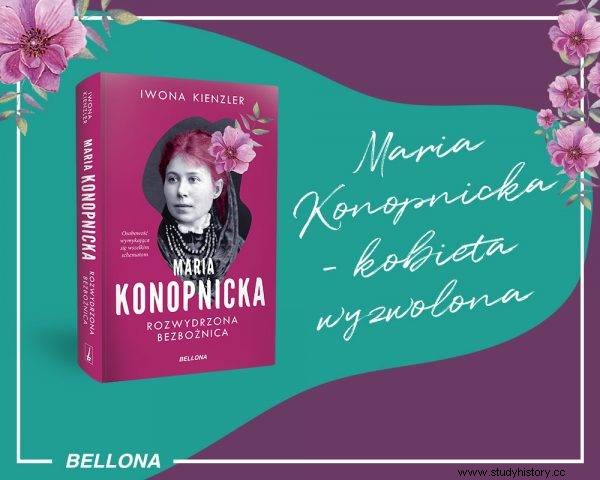The author of "Rota", whose talent Sienkiewicz admired, aroused numerous controversies. What did Konopnicka do that she called her a "ravaged godless"?
Today she is mainly known as the author of Rota and ... the heroine of the scandal related to the so-called "Konopnicki lie". However, the disputes over the nature of her relationship with Maria Dulębianka do not exhaust the controversy surrounding the figure of Maria Konopnicka. She was not a pious national poet and a Polish Mother, whom many wanted to consider her to be!
All our children are - except their own
Konopnicka went down in history mainly due to her patriotic works. She is also associated with poverty as the author of the fairy tale About dwarfs and the orphan Mary . But elevated to the role of the Rota anthem , which the poet published at the end of her life, overshadowed her diverse works. For decades, Maria wrote poems, fairy tales and short stories. She dealt with literary criticism and translations.
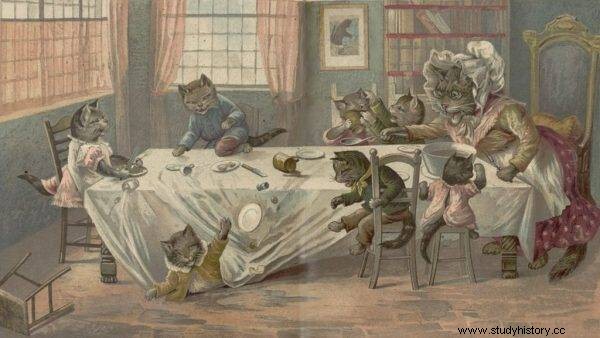
Illustration for the book "Filuś, Miluś and Kizia:merry kittens" by Maria Konopnicka
The lion's share of her works was also ... children's literature. As Mruczysław Pazurek she published, among others, a nice volume of poems Filuś, Miluś and Kizia. Happy cats . Already under her own name, she has also published collections My book, Wesołe moments small readers or School adventures of Pimpuś Sadełko . Her love for children showed through her funny, imaginative pieces. But are you sure? Iwona Kienzler in the book Maria Konopnicka. A ravaged godless writes:
She was seemingly a wonderful mother, the embodiment of the proverbial Polish mother who brought up a group of children alone, but when they became independent a little bit, she quickly fled from Warsaw to lead a nomadic life for almost twenty years and travel all over Europe. She kept in touch with the children, and even supported them materially and took care of their affairs, but she did so more out of a sense of duty than out of the need of the heart. (...) To make matters worse, she divided her children into better and worse, she completely turned away from her mentally ill daughter, and she was almost completely uninterested in her grandchildren.
Concerned Polish Mother and "that monster"
The apple of her eye was her eldest son Tadeusz (he was named in honor of the hero of the poem by Mickiewicz). Apart from him, "successful" children were Jan and the eldest of his daughters - Zofia. The remaining three - the middle son Stanisław and the youngest daughters - Helena and Laura - caused Konopnicka only worries . It was on the poet's hand. In the correspondence, she pretended to be a "worried mother". However, the reality was not so rosy.
In a letter to Eliza Orzeszkowa, Konopnicka disagreed:“The party to which I belong, body and soul, are my children. Outside of them, there is only a world of thought and work for me ”. In fact, after splitting up with her husband and moving to Warsaw, she worked harder to provide for the entire group of people. Anyway, she also had to pay for the children when she grew up. Also, the "successful" ones fell into financial difficulties from time to time. And if there is fear, then to… mother.
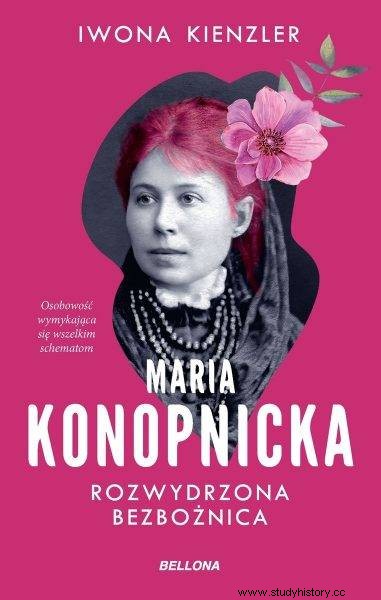
The text was created, among others based on the book by Iwona Kienzler “Maria Konopnicka. A ravaged godlessness ”(Bellona, 2022).
On the other hand, when Helena, second to last in the order of births, fell mentally ill, Konopnica publicly cut herself off from her. After her daughter's unsuccessful suicide attempt, in a letter to her husband, she expressed her dissatisfaction with the fact that ... the girl did not really take her own life. “(...) make an incredible scandal for the whole family (...) and, at the same time, do not endanger his precious health even with a hair. If there were even three matches, she would scrape and swallow - but nothing. It would be ridiculous, wouldn't it then, but yes - it's ultimately mean. ”
In correspondence with the older Zofia she called Helena "that monster". She was called "freak", "terrible creature". She also urged the girl's father to sign a declaration that "the family renounces all solidarity with H. and has nothing to do with her." Meanwhile, the daughter, suffering from kleptomania and hysteria, constantly sought her mother's love. Although it must be admitted - she did it in an aggressive way. Konopnicka's reaction? Moving out of Warsaw to cut myself off from a degenerate child once and for all ...
The godless national prophetess
But it was not the abandonment of her own daughter in need that made Konopnicka "fallen" to the Church. Moreover, the scandalous decision to abandon her husband did not lead to it - without any efforts to annul the marriage. (There was no question of divorce, as they were not allowed under the then law). Moreover, it was not due to the romances with younger men, or even the long-lasting "suspicious" relationship with the painter Maria Dulębianka, which Konopnicka called her Providence. So what was it about?
The answer is given by the opinion from "Przegląd Katolicki", the author of which unflatteringly said about the poet:" Her thought is godless and blasphemous. (...) she threw in the face of the Church once more the miserable insult that her enemies had thrown on her so many times ”. Why? Because the poet dared to present the profiles of great scientists persecuted by the Church.
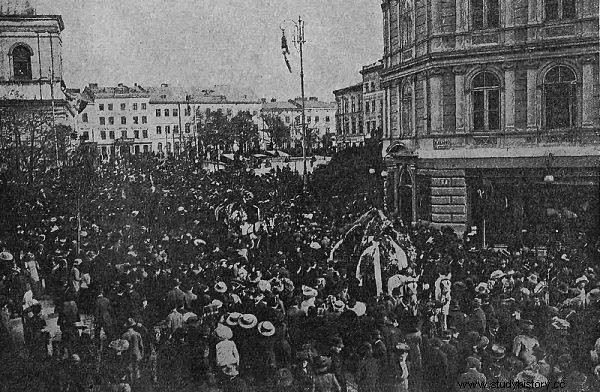
Konopnicka's funeral became a great patriotic demonstration. There were no priests there - they were forbidden by the archbishop
It was about a job From the past. Dramatic fragments from 1881. The poet's friend, Eliza Orzeszkowa, published this controversial book, although she had no doubts that it was an openly heretical book. Wiesław Grochol in Konopnicka's biography as the cause of the scandal related to the publication of From the past ... indicated the fact that Maria opted in the book for "freedom of thought and scientific inquiry against the forces of retrograde and superstition." And it was by no means the only anti-clerical publication by Konopnicka.
Wasted in national service
Critical voices from Catholic-national circles died down when Konopnicka began to publish her poems "to refresh hearts". The sad truth, however, was that she wrote patriotic songs less because of the need to fight the invader, but rather - for money . As Jan Lechoń summed it up:
Konopnicka was probably the greatest victim of both poverty in our literature, which made her earn money by writing patriotic "hits", and the Polish fate, which made poets work for politicians, priests and the army. (...) could be a poet in poems, if she did not have to pretend to be a fortune-teller, queen, instruct, warm and encourage. Today I found a poem in her volume You star , shocking to know that she has wasted herself in national service, that she has been broken by working for bread.
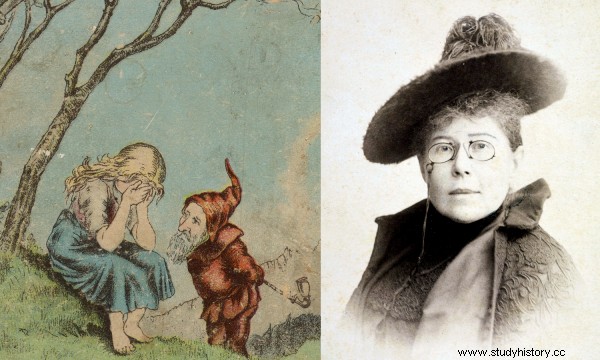
Today, Konopnicka is remembered mainly as the author of "Rota" and "About the orphan Marysia and the dwarfs"
Perhaps this - and her rebellious life - meant that in the eyes of the Church, Konopnicka never managed to wash away her "sins of youth". The best proof of this was the scandal that broke out over her funeral. Iwona Kienzler in the book Maria Konopnicka. A ravaged godless describes:
Konopnicka's funeral took place on October 11, 1910 and, as could be expected, it became a great patriotic demonstration. On that day, work and education in Lviv schools were interrupted, and a crowd of many thousands of people burst out onto the street. However, it was not without glitches, because the announced participation of the clergy and the speech of Bishop Bandurski were canceled. All because of the prohibition of Archbishop Bilczewski, who did not fail to remind of the sins of the deceased "ravaged godless" against the Church as well as to point out that the poet could hardly be considered an orthodox Catholic during her lifetime.
Great poet
But did she really deserve such a condemnation? History has shown that it is not. It is about Konopnicka, not about Bilczewski, we remember to this day. The controversy surrounding her colorful life is also largely a thing of the past. Regardless of the complicated family relations and conflicts with the Church, the evaluation of Konopnicka's character is rather positive today . Although numerous white spots and distortions in her biography do not make it easier to answer the question of what she really was. (Anyway, the poet herself put her hand to it, skillfully falsifying her own biography).
Undeniably, Maria Konopnicka was incredibly talented. Henryk Sienkiewicz wrote about her: "this lady or maiden has a real talent that shines through the poems like the rays of dawn through the fog" . It should also be remembered that as a woman, single mother and Polish woman from the very beginning she had a "hill". It can certainly be said, however, that Maria Konopnicka was a great poet. 